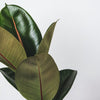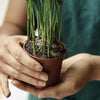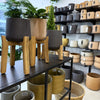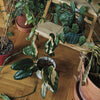Caring for little "baby" maids

Almost all of us have plants at home, we like to take care of them and we like to watch them grow nicely. However, many people prefer to buy small plants and especially the smallest ones, which we call "baby houseplants".
However, there are also small risks with small plants, and we will look at them in today's article.
When we get small plants
With small plants, it can easily happen that the type of plant is confused, especially with those where we have a lot of species that only slightly differ in their color, which we often only recognize when they are mature. A beautiful example can be, for example, Syngonium White Butterfly and Syngonium Pixie , which look practically the same when they still have tiny leaves and the plant barely reaches a few centimeters.
For small plants, especially on store shelves, make sure that the plant is not too dry and that the leaves do not dry out. If it looks like it's not in good shape, don't take it. For small plants, the biggest problem is a forgotten watering and an unsuitable flower pot, see below.
Keep in mind that "baby houseplants", even if you get them tiny, usually grow as fast as larger houseplants in pots up to 8 cm in diameter. Unfortunately, in a small pot of this size, the plant does not have room for a good development of the root system, and the plant will quickly begin to suffer when the roots fill the pot. So it will be relatively soon time to transplant to a bigger one.

Transplanting into a larger pot and which one to choose?
Small plants are usually planted in a breathable substrate in extremely small pots, either plastic or terracotta (ceramic). If you have decided to transplant the plant into a larger one, always choose a pot that is at most 2-3 cm larger . This is for the reason that it is not suitable for the plant to give it too much surface area in the substrate, which would lead to more frequent overwatering of the soil and rotting of the roots. This allows the plant to grow gradually.
It doesn't matter if you choose a ceramic, plastic, glass or other flower pot, choose according to the type of plant, its requirements and location in your apartment. However, make sure that the plant breathes, i.e. create drainage from expanded clay at the bottom of the substrate in the flower pot or from other materials, e.g. from perlite for better drainage from below.
You can use the substrate according to the type of plants, but for the very smallest ones, a classic substrate for green plants with the addition of perlite is usually sufficient. For smaller plants, be careful with the amount of perlite, as it speeds up the drying out of the substrate and the plant could dry out before you know it.
Dressing
It is generally not recommended to use terracotta pots for small plants. These are breathable on their own and plants can dry out very quickly, even in a single day. So consider your options and how often you want to look after your plant. For the smallest plants in terracotta, there is no need to deal with drainage, on the contrary, add water to the saucer to make sure that it has a supply of water.
You can fertilize small plants, but be careful with the amount, fewer roots will tolerate less fertilizer and you could burn the roots if you overdo it.
Lignohumát , on the other hand, can make you sure, which helps the roots with their development and generally benefits the plant at a time when fertilization is not so recommended, e.g. in the winter months.

Photo: Peperomia glaucophylla Greeyzy
Advantages of small bedrooms
Whether you prefer small or larger and more lush houseplants, the advantage of small plants is that you can watch them grow, see their development from baby to adulthood, and at the same time, with many plants, you control their shape and quality thanks to your care.
In addition, if you don't like to grow houseplants in the substrate but are, for example, a lover of hydroponics , then small houseplants are the most suitable adept for hydroponics, before they start to grow and their transition would be more complicated.
And what are your favorite maids?
Let us know in the comments in our Facebook group under the article which little houseplants you like best :) The succulent Hoya Kerri is undoubtedly one of our most popular baby houseplants. Spathiphyllum Pearl Cupido , which we have recently expanded to a larger size , is among the very popular and great for care.
Author: Martin Seidl
-
Posted in
Péče o pokojovky, Zajímavosti a tipy




